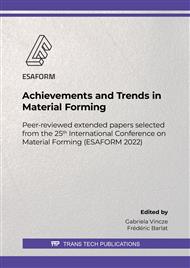p.1864
p.1874
p.1882
p.1890
p.1900
p.1907
p.1914
p.1923
p.1931
Measurement and Analysis of Deformation Behavior of Polyethylene Tube Subjected to Linear Loading and Unloading Stress Paths with Large Strain
Abstract:
A material testing apparatus for measuring the biaxial deformation behavior of a polymer tube has been developed to quantitatively evaluate the deformation behavior of polymeric materials. The testing apparatus can apply axial force and internal pressure to a tubular specimen. A noncontact strain measurement system was also developed, and the biaxial strain components and the radius of curvature in the axial direction of the bulging specimen are continuously measured to control the stress path applied to the specimen. Polyethylene tube with an outer diameter of 17 mm and a thickness of 2 mm are used as a test sample. The tubular specimens were subjected to linear stress paths with stress ratios of σΦ:σθ =1:0, 4:1, 2:1, 4:3, 1:1, 3:4, 1:2, 1:4, and 0:1, where σΦ and σθ are the axial and circumferential stress components, respectively, applied to the central area of the bulging specimen. Loading and unloading tests were performed to determine the biaxial true stress-logarithmic plastic strain curves. The strain rate was 1×10-3s-1. From these test results, contours of plastic work and the directions of the plastic strain rates were measured to identify a proper material model for the test sample using the Yld2000-2d yield function (Barlat et al., 2003).
Info:
Periodical:
Pages:
1900-1906
Citation:
Online since:
July 2022
Keywords:
Permissions:
Share:
Citation:


